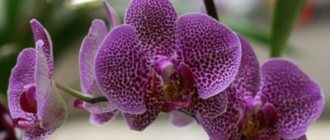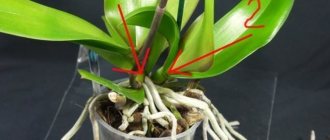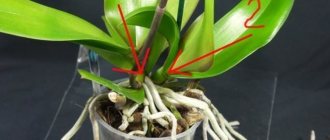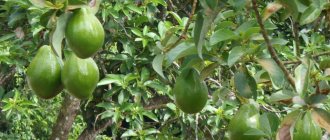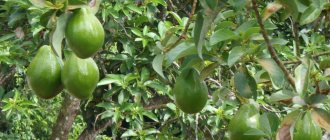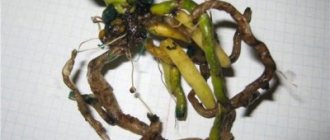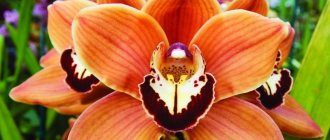What is a peduncle
Peduncles in orchids are shoots that form from below on the above-ground part and grow upward. After the formation of a peduncle, flowers bloom on it. When the arrow just begins its formation, it is easy to confuse it with the roots or children of the epiphyte, since there are very few differences. Therefore, it is important to be able to distinguish the peduncle from the root of a phalaenopsis or its offspring.
To distinguish the peduncle of an orchid from the root and children, pay attention to the following signs:
- the roots have a rounded shape, and the flower arrows are cone-shaped;
- a flower arrow can be distinguished from a basal arrow after a while, when it grows a little, the shape of its tip becomes like a boat;
- the central vein of the leaf becomes the place of formation of the flower arrow;
- usually the arrow forms in the same place where there was flowering before;
- The main difference between the peduncle and other parts of the plant are the buds that bloom on it after final formation.
The flower stem at any stage of development is covered with irregularities in the form of scales or small spines. They are dormant buds.
It is the peduncle that is responsible for the beauty of the orchid. After all, over time, buds form and flowers bloom on it. In its upper part there is a green tip, which represents a growth point. As long as it is alive, new flowers will appear on the stem.
How does an orchid bloom at home?
The growth of flower stalks in orchids is a rather unusual process. This can happen differently each time. For example, a peduncle can bend, resembling a tail, and then begin to grow upward.
It is easy for experienced flower growers to determine the beginning of the growth of a peduncle and distinguish it from the root. But beginners will have a hard time, because at first glance it is absolutely unclear whether the long flowering period has begun or whether the root of the plant is still peeking out.
Photo of how to distinguish the root from the peduncle.
So, how do you know that a plant will bloom ? It is worth remembering that indoor orchids begin to grow new leaves at the end of summer or early autumn, while flower stalks begin to grow only towards the end of the autumn period.
A situation that is often unpleasant for novice gardeners is when, after purchasing a non-flowering orchid, the plant is in no hurry to produce a flower arrow.
Don't panic and take your tropical beauty back to the store. Perhaps the orchid is still too young: depending on the type of plant, they can bloom at the age of 1 to 3 years.
If, when counting the shoots, it turns out that the orchid is already quite mature, and the flowering period has not yet begun, experts recommend putting some kind of stress on the plant.
Sometimes it happens that a flower stubbornly refuses to shoot an arrow because its life is too comfortable . Yes, yes, you shouldn’t be surprised and remember that an important aspect in caring for an orchid is comfortable conditions.
All this is true, however, a small stimulation for flowering will be the so-called “shock” for the plant. For example, reduce the dose of watering or move the flower to another location.
It is worth referring to two simple rules that will help determine that the plant has released an arrow:
- Peduncles appear in the corners that form between the leaf and stem of the orchid. If we turn to botany, we can find out that it is in these places that the bud appears;
- The peduncle from the very beginning has a rather complex structure. In contrast to the smooth surface of the root, the peduncle has rudiments that look like scales.
The structure of an orchid.
IMPORTANT! During the growth period of the peduncle, it is strictly forbidden to touch the orchid, including replanting it. This applies, first of all, to indoor plants.
a pseudobulb or false bulb is . The main difference between a bulb and a pseudobulb is that the former are formed exclusively on the vertical parts of the shoots, while false bulbs are formed on the horizontal ones.
However, the pseudobulb is of no small importance - it helps the orchid survive in conditions of extreme drought in nature . It is quite difficult to describe the specific type of bulbs and pseudobulbs, because their varieties can be of completely different shapes and sizes.
The main function of the false bulb is to preserve nutrients “in reserve” in case of difficult, dry times. Bulbs are an excellent assistant in the processes of photosynthesis.
Age of onset
The primary factor for when an orchid should begin to bloom is its age. Therefore, experienced flower growers recommend that you definitely find out how old the capricious beauty who proudly occupies her place on the windowsill is.
To determine the exact age of an orchid, you should pay attention to the number of exotic leaves. The flowering period can only begin when the plant has at least 5-8 leaves.
Therefore, you should not be upset if the flower does not yet please with beautiful inflorescences; most likely, the plant is still too young, and the flowering of such specimens can lead to subsequent death.
IMPORTANT! We must not forget that only adult plants are capable of forming flower stalks.
How does a flower bloom?
The flowering process , which includes the beginning of the growth of the peduncle and the opening of the buds, takes about two months . With proper care and comfortable conditions for growth and development, an orchid can delight its owners with magnificent flowers for several months, and such magic happens about two to three times a year.
An orchid is preparing to bloom.
IMPORTANT! Active flowering can continue in several stages. Sometimes it happens that the first inflorescences quickly wither, but do not panic when the buds that formed a little later begin to bloom.
The flowering period depends solely on the genetic data of the plant . An orchid can produce flowers for up to three months, and some species - up to six months.
Care before the appearance of the peduncle of the orchid and during the growth period
Until an arrow appears on the epiphyte, cultivation is carried out according to standard rules. The flower is provided with diffused lighting. To do this, it is moved from the southern window sill in mid-spring. Water the plant so that the soil dries out for several days between irrigations. This will enable the root system to take part in the process of photosynthesis.
The plant is provided with an influx of fresh air and at the same time protected from drafts. Cold is especially dangerous for orchids in winter. Damaged parts cannot be healed. Therefore, frozen tissues are cut out. Air humidity in the room is maintained at least 65%. During this period, the flower is regularly fed with special fertilizers marked “For orchids.” Others are not suitable for epiphytes because they burn the root system.
During the formation of the flower arrow, the care of the epiphyte changes. Therefore, it is important to know how to care for an orchid when it has released a peduncle.
After the orchid has a peduncle, irrigation is reduced. But at the same time, the flower is not subjected to overdrying. To do this, increase the interval between watering for drying to 5 days instead of 2-3 under the usual cultivation regime. Then the orchid is watered not once a week, but twice a month.
While the orchid’s peduncle is growing, the addition of nutrients is reduced. Fertilizing is completely abandoned when the plant begins to form buds. If this is not done, flowering will be short.
If the orchid has put out an arrow in the fall or winter, the pot is moved to the south side. If this is not possible, additional lighting will be provided. Otherwise, the shoot will stop developing. For good development, the arrows maintain the air temperature in the room from +23 to +26 degrees. Lower temperatures reduce the growth rate and cause the arrow to dry out.
Important!
The number, size and color of the buds largely depend on how carefully the plant was cared for in the last 120 days before the formation of the stem. If fertilizing is applied only at the moment the peduncle appears, there will be no abundant flowering.
Features of care
The period of growth of the peduncle is of great importance, because how you care for the plant at this time determines whether your phalaenopsis will please you with flowers, or whether you will only admire its foliage.
Sufficient amount of light . In the autumn-winter period, natural light may be sufficient for a plant only in one case - if the window on which the pot stands faces the south side. In all other cases, additional lighting with a special phytolamp is necessary. Daylight hours for a phalaenopsis that has released a shoot should last at least 12 hours.
Optimal humidity conditions. Phalaenopsis love moisture, and in winter there is not enough of it in the dry air of our apartments.
Hence the recommendation: use a humidifier, especially since it is also useful for people. Watering at this time is carried out as usual - as the substrate in the pot dries. This is an individual parameter, it depends on the temperature and humidity in the room. IMPORTANT ! The substrate in the pot cannot be brought to a completely dry state; this can destroy the phalaenopsis. Watering should be done when the substrate is still slightly (key word “slightly”!) moist inside.Direct spraying is not required for a plant with a peduncle, and may even ruin the young shoot. Just place the pot deep into the group of flowers that you will spray, and the resulting water mist will be quite enough for the phalaenopsis.
And finally, proper feeding of the plant . Fertilizer during the period of flower stalk formation and subsequent budding should contain a large amount of phosphorus and potassium. It is highly desirable that this be a mineral fertilizer intended specifically for orchids. Fertilizing is carried out no more than 1-2 times a month, and is stopped when flowers appear.
Growth Characteristics
In ordinary phalaenopsis, the peduncle grows for 2 months. Hybrid varieties produce flower stalks longer. Their formation period takes 3 months. During this time, the newly hatched stem turns into a full-fledged arrow. Depending on the growth conditions of the Phalaenopsis orchid, the interval may increase or decrease.
When provided with the right amount of light, sufficient humidity, warmth and nutrients, the growth process is 2 times faster. The side stems grow even faster and are fully formed in 1.5 months.
Typically, an orchid produces 2 to 3 flower stems. Sometimes in florist shops you can find plants with a lot of arrows. At home, the number of flower stalks is determined by the growing conditions of the plant and its care.
After the orchid shoots, it is important that it grows evenly and looks beautiful during flowering. To do this, perform the following steps:
- When the arrow grows to a length of 20 cm and is strong, it is fixed vertically.
- An orchid with a peduncle must be tied to a support using a special clothespin. If you don’t have one, use a regular hair tie or crab clips.
- If it is impossible to tie the flower stem, the pot is regularly unfolded as the arrow develops. Then it will reach out to the light and grow in the right direction.
What does the appearance of a new flowering stem mean?
As soon as the last leaf of the orchid appears, it prepares to release a peduncle.
If a new leaf and peduncle appear at the same time, then you need to let the plant choose for itself what to develop next.
In order for your flower to delight you with its inflorescences, it is important to follow some rules of care.
- Temperature regime . In order for the orchid to go dormant without stress, it is necessary that the temperature does not exceed 26 degrees and does not fall less than 15 degrees. When a peduncle appears, the temperature is slightly increased.
- Moisturizing the flower should occur as usual. If the soil is dry, water it. Do not overwater the orchid; the root system will begin to rot.
Feeding . Do not stop feeding the orchid even during the dormant period until the first flower appears. It is not recommended to feed during the flowering period.- Location . Do not replant or move the flower to another place. It's stressful for him.
- Lighting . Take care of the lighting. Without full daylight, the plant will not bloom. If there is less than 10-12 hours of daylight per day, then the orchid needs to install a lamp. Make sure that the plant does not heat up. If it is not possible to provide lighting to the entire plant, then illuminate only the peduncle.
- Take care of your roots . Do not injure the root system under any circumstances. It is best to purchase transparent plastic containers with plenty of drainage holes.
- Hydration . During dry periods, it is necessary to moisturize the orchid. Simply place a plate of water next to the plant. Don't forget to spray.
After the arrow dries, it should be carefully trimmed.
Make sure that the peduncle is completely dry, otherwise the living tissues of the flower may be damaged. The height of the hemp should not exceed 2 cm. Be sure to treat the cut area with a composition based on activated carbon. Often, a plant can continue flowering after a short rest or even without it at all. The cut stem can also produce babies - new plants that can be replanted. With proper care, the orchid will bloom from 2 to 6 months . Read more about what to do with the arrow when the orchid has already bloomed here.
How to prevent a stop in the development of the arrow
When a flower stalk appears on the plant, it is important to create comfortable conditions. Then the arrow will constantly develop and will not stop developing. To do this, it is important to ensure that the lighting does not decrease. If the length of daylight hours has decreased, additional illumination with phyto-paws is organized.
Waterings are gradually reduced and the interval between them is increased. It is important not to overdry the plant. The temperature in the room is maintained at the optimal level for good growing season. Fertilizers are applied on time in accordance with the attached instructions.
How to make phalaenopsis shoot arrows at the same time
Usually an orchid produces only one arrow on which flowers form. You can grow several flower stalks only on an adult plant that has from 8 to 10 leaves in a rosette. Such an orchid often produces 2-3 flower stems, but it is not capable of throwing out more than three.
By expelling several flower arrows, the plant is stressed. Then, after abundant flowering, the orchid will begin to hurt, and it will develop a loss of strength. Therefore, experienced gardeners do not advise artificially stimulating the plant to form more than two stems.
Why doesn't it appear?
If all the rules of care are followed, and the orchid still does not bloom, pay attention to the age of the orchid. The plant begins to bloom for the first time after 1.5-3 years.
Perhaps the flower is still too small. To find out the age of a plant, you can count the number of shoots . An adult plant has from 5 to 8 shoots.
It often happens that the plant is too happy, since all the rules of care have been followed. The flower is happy and receives the necessary amount of light, warmth, and nutrition. Therefore, he devotes all his efforts to the growth of green mass. In this case, you can stress the orchid. Reduce watering or move the pot to another location. But don't go overboard with the shock factor. Read more about how to force an orchid to produce several flower stalks if it is stubborn and does not produce even one.
For amateur flower growers, the most joyful event is the blooming of an orchid. For a flower to please your eye, it needs proper care and attention . Remember, the main thing in everything is not to overdo it. It is sometimes useful to “scare” an orchid for bright flowering.
Possible problems
Sometimes the peduncle of an epiphyte does not grow for a long time or the arrow has grown incorrectly. Often, flower growers with little experience break the flower stem. In this case, you need to understand the cause of the problem and determine actions to solve it.
Actions after flowering is completed
When the flowering period ends, caring for the flower depends on the condition of the flower stem. If the shoot turns yellow and shows signs of drying, it is cut off at the very base. The resulting wound is sprinkled with crushed charcoal or ground cinnamon to prevent infection. You can use chalk for the same purpose.
When the stem itself is green and the apical bud has dried up, the stem is shortened. The cut is made slightly above the first living bud. Exposed fabrics are treated with cinnamon, charcoal or chalk for disinfection.
If there are no signs of wilting or drying on the stem, it stands green, with healthy buds. After the end of the dormant period, buds will again form on such a stem and flowers will bloom. Therefore, you don't need to do anything with it.
